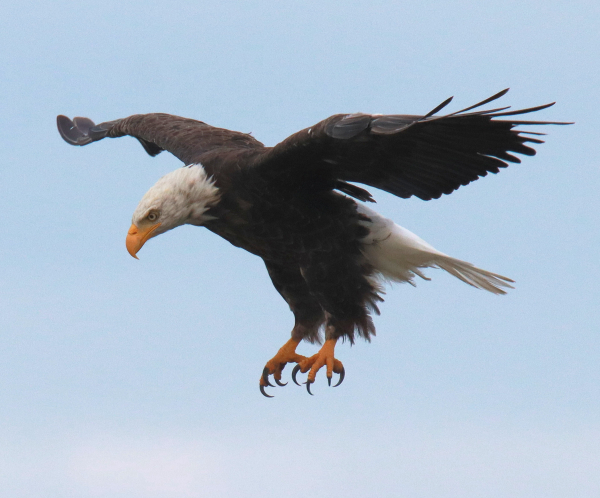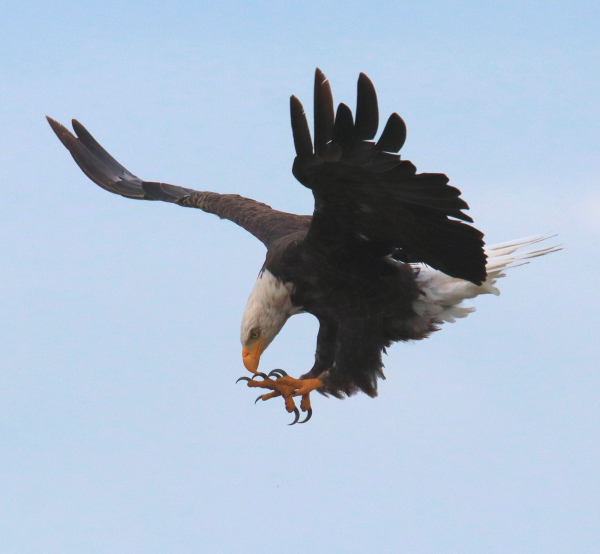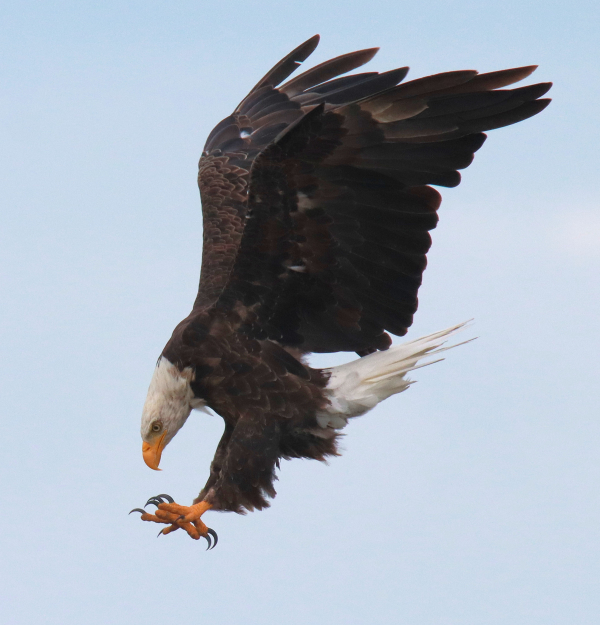
Starting from an almost stationary position with its legs dropped and talons barred, the adult Bald Eagle began a dramatic dive that was only compromised by the lack of sunlight (600mm zoom lens, f-8 aperture, 1/2500 shutter speed, and 800 ISO).




All that dramatic action just to land on a pole?
|
As I wrote a couple weeks ago: “Rarely are we able to take a perfect photograph of a bird, even in the best of conditions.” Last week, I had a reminder of that very fact. A Bald Eagle I have come to know a bit over this summer was perched on the edge of Charo Marsh close to the road I was following. I spied the eagle from quite a distance away, and also saw a large truck raising a plume of dust as it approached the eagle at considerable speed. Even so, the eagle didn’t seem to flinch and I waited a moment for the truck to pass by me before making my next move.
Having witnessed the eagle’s lack of concern for a passing truck, there was probably a pretty good chance of getting into position to take a photo. I stopped my auto within camera lens range without disturbing the adult Bald Eagle, but the catch was that the formerly clear sky had just been enveloped by a vast bank of clouds 5 minutes before. With little chance of a quick change in the cloud cover and lack of direct sunlight, I took a couple photos of the eagle as it was perched, looking out across the open marsh. I have lots of fine photographs of adult Bald Eagles, so my excitement level was muted at this point, but there is always a certain hope for some level of action to take place to create a better photo opportunity.
It’s always important to get into position, take a quick photo or 2 or 3, and hope the bird might provide some level of action. So I waited; but not long. Suddenly the eagle spread its wings and jumped upward into a stout wind that caught its broad wingspan and seemed to flip the eagle backward and to the side. I managed 2 photos, but neither were very good, so I followed the eagle as it flew above the shallows to the east side of the open water. When it began to retrace its flight back toward my position I focused on the eagle again as it flew headfirst into the stout wind.
As it approached I took a photo, then another, until the grand eagle seemed to float in the sky with its wings outstretched and its legs dropped low, which raptors often do to help stabilize their flight. The interesting thing was that its feet were open with its talons bared. The resulting image showed the eagle with a very intent look – seemingly like it was zeroed in on a fish – so the action was perhaps about to begin!
From that floating point, the eagle began a rather rapid descent, with its hooked yellow beak and 8 formidable talons positioned as if to make a dramatic hunting strike. In fact, at one point the eagle’s position was especially intense with its beak and open talons zeroed in, with its wings spread forward in a braking action, then thrust backward in dramatic fashion to position in full dive mode. Following the eagle’s movements through my camera lens I was imagining a big splash into the water to catch a fish, but to my surprise and against all the obvious indicators, the eagle merely landed on the same pole where it began its impressive flight. What?!
Within the next minute the adult Bald Eagle took flight again, retracing its flight east along the shoreline, then back in my direction; but this time it turned and flew to the center of the far shore where it perched on a tree trunk snag where I have occasionally seen the eagle resting or watching for its next fishing or hunting opportunity.
While the resulting photographs are quite spectacular in form, they obviously lack the quality of the photos that usually illustrate Bird Photography articles. The quality just wasn’t there due to the lack of good sunlight, a lack of shadows, or a blue sky background to emphasize the brown and white eagle. Nonetheless, the images were very impressive, individually and as a dramatic series of images of our National Bird. Hence, I did what I could to improve the photographs, first by cropping extraneous gray sky. And then I ventured into an area of photo editing that I don’t like to enter: Brightening and sharpening the image within a computer program’s darkroom.
It was an act of desperation for me – the images seemed to have merit, yet they were mostly a dull black bird with white head and tail plumage flying in the midst of a gray sky. However, the resulting photographs were improved to such an extent that I was very surprised. The sky even retained some blue color in the heavily edited photos. That said, the images were rescued to some extent, and they are in many ways representative of what we sometimes are faced with when we take one of a kind images that we want to resurrect from the editor’s wastebasket.
The action positions of the eagle in this series of photos are quite impressive, especially when you consider that the eagle made the seemingly predatory diving movements, only to land on a pole. If nothing else, this photo sequence is reason to emphasize to make the most of any photo opportunity under the conditions at hand; and to wait for a static bird to take action and use the opportunity for practice if nothing else. But aren’t we lucky to have access to the digital photo equipment available today, including photo editing computer programs!
For a look at higher quality photographs of a Bald Eagle, I offer a second Bird Photography article as a feature at the end of this issue. I took those eagle photographs the same week as the interesting series of photos, and while there is no action to see in those images, they are much sharper, more detailed, and better quality photos.
Article and Photos by Paul Konrad
Share your bird photos and birding experiences at editorstbw2@gmail.com